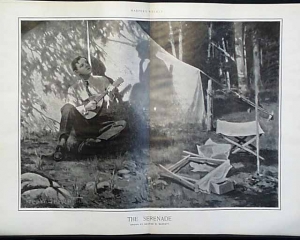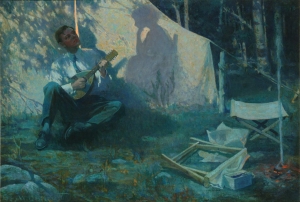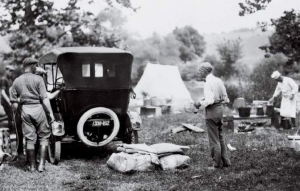- George Watson Barratt (1884-1962)|The Serenade, 1911|Illustration for Harper’s Weekly (June 3, 1911)|Collection of the Delaware Art Museum, 1986-53
Summer is here. The insert ads in our local newspapers include a variety of equipment used to enhance our seasonal out-door activities like sports, picnics, and camping out. While recreational camping may feel as though it’s been around forever, in fact it is a phenomenon of the late 19th and early 20th centuries. Settlers traveling in their Conestoga wagons must have done something similar out of necessity as did foot soldiers on the move. The earliest publications indicate that camping as an leisure activity date from the 1880s*; recreational camping was further popularized in the wake of the development of the Boy Scouts and Girl Guides first in Great Britain in 1907 and in the United States in 1910, with their dedication to wood craft and wilderness survival.**
In the late 19th century camping was part of hiking and climbing activities and as such it was important to consider the weight of what you carried as you planned your excursion. In an article on “Camping Equipment” published in two subsequent issues of The Outing Magazine early in 1907, the author admonished, “There is more danger that a man take too much than too little into the wilderness.”*** Later the author emphatically stated, “An article must pay in convenience or comfort for the trouble of its transportation.”
While there were always ways to carry more equipment and food, such as on a horse or in a wagon, it is not until we began to commonly employ mechanical means of transporting equipment that more people began to explore the lure of the out-of-doors. By 1910 American campers could use bicycles or automobiles for transport. According to Roger White of the Smithsonian, in 1910 there were also three recreational vehicles being manufactured in the United States.**** In the Outing article mentioned above, the author let us know that a 7 ft. x 7 ft. cotton tent weighs about 25 pounds when dry, so it’s no wonder that packing a substantial tent typically necessitated using some sort of transport.
During the first decade of the 20th century books were being popularly published with advice on camping and cooking out-of-doors. Horace Kephart, who helped plot the route of the Appalachian Trail through the Smokies, wrote in his book on camping, “If one would realize in its perfection his dream of peace and freedom from every worldly care, let him keep away from summer resorts and even from farms; let him camp out; and let it be the real thing.”*****
I find it fascinating that George Barratt’s double-page illustration The Serenade for June 1911 Harper’s Weekly began as a full color painting instead of being initially produced in grisaille tones as his teacher Howard Pyle might have done. The Serenade shows a trail of smoke rising from the coals of the campfire at the far right of the image. Next to the fire two camp stool rest, one opened, one collapsed. Nearby a young man sits in front of a tent, strumming his mandolin in the moonlight that is strong enough to cast leafy shadows across the man and the wall of the tent. Inside the slightly open tent flaps a lick of light is visible behind the man. Because the tent is lit from within, the silhouette of the woman seated inside the tent is seen against its white canvas walls. She sits on a camp stool with a seat back and listens to the man’s undoubtedly romantic song. How enticing this image is in conveying the romance between man and woman as well as the romance of the rustic out doors.
- So popular was recreational camping that between 1915 and 1924 even America’s most famous industrial leaders, Henry Ford, Thomas Alva Edison, and Ohio tire magnate Harvey Firestone went on a series of highly publicized camping trips together with John Burroughs, an American naturalist from the Catskills and a bevy of helpers. Calling themselves the Four Vagabonds, their camping travels reflected contemporary American’s desire to explore and revel in the beauties of nature. As John Burroughs wrote, they desired to “be not a spectator of, but a participator in, it all!******
Dedicated to Allen L. Buch, who shared his joy of nature and camping with his children.
* The earliest book on recreational camping I located was Howard Henderson’s Practical Hints on Camping produced in Chicago by Jansen, McClurg and Co., in 1882.
**According to the Encyclopedia Britannica, “The founder of modern recreational camping was Thomas Hiram Holding, who wrote the first edition of The Camper’s Handbook in 1908. His urge to camp derived from his experiences as a boy: in 1853 he crossed the prairies of the United States in a wagon train, covering some 1,200 miles with a company of 300.”
*** Stewart Edward White, “Camp Equipment” in The Outing Magazine vol. 49 no. 4 (January 1907): 404 and 405.
**** John Rixey Moore, “Celebrating 100 Years of Travel by RV,” Rvmagonline (August 2010) at https://www.rvmagonline.com/features/1008rv-celebrating-100-years-of-travel-by-rv/index.html
***** Horace Kephart, Camping and woodcraft: a handbook for vacation campers and for travelers in the wilderness (Knoxville : University of Tennessee Press,
***** John Burroughs, Our Vacation Days of 1918. Privately printed by Harvey Firestone, after 1921. “Respectfully dedicated” to the memory of the great naturalist, John Burroughs (1837-1921).
June 16, 2011
By Joyce K. Schiller, Curator, Rockwell Center for American Visual Studies, Norman Rockwell Museum









